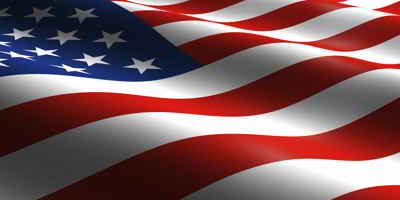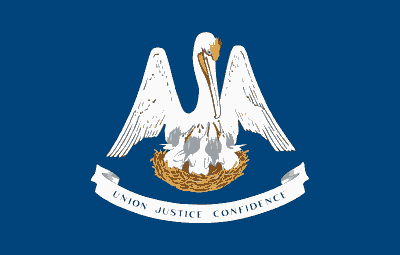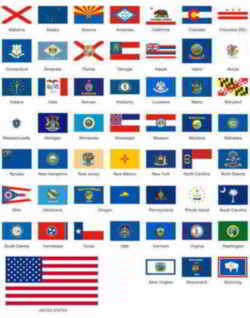

Louisiana Symbols
Louisiana State
Flag
Adopted in 1912.
The state flag of Louisiana was adopted by an Act of the Legislature in 1912. The flag of Louisiana consists of a heraldic charge called a "pelican in her piety," representing a mother pelican wounding her breast to feed her young from the blood. The mother pelican's head and outspread wings covering the three pelican chicks nested below her form a stylized fleur-de-lis, another emblem of similar significance often depicted in Louisiana. This symbol, emblematic of Christian charity (and Catholicism), is also found on the state seal. On the flag it is depicted above a ribbon with the state motto: "Union, Justice, and Confidence". The current flag was adopted in 2006, revising the original pelican design of 1912.
During the 19th century it was traditional in Louisiana flags and the state seal for the "pelican in her piety" to have three drops of blood on her chest. However, in later years the tradition (on both the state flag and seal) had been haphazardly followed, which was noticed by an eighth-grader at Vandebilt Catholic High School in Houma who brought this to the attention of his state legislator. The issue was resolved in April 2006, when the Louisiana State Legislature passed a bill (House Bill 833/Act 92) which requires three drops of blood to be depicted on the pelican used in both the state's flag and seal.
The Louisiana State Flag
Flags of many nations were raised over the Louisiana Territory before Louisiana became a state, notably flags of the French, the Spanish, the United States and the Confederacy. This official flag of Louisiana is that flag now in general use, consisting of a solid blue field with the coat-of-arms of the state, the pelican feeding its young, in white in the center, with a ribbon beneath, also in white, containing in blue the motto of the state, "Union, Justice and Confidence".
- Flag of Castile and Leon (1492-1541)
1519, the Spanish explorer Alonso Alverez de Pineda led an expedition along the northern shores of the Gulf of Mexico. He discovered the mouth of a great river-in all likelihood the mighty Mississippi. - White Fleur de Lis (1672-1762)
The first explorer to travel down the Mississippi River to its mouth was Frenchman Sieur de LaSalle. In 1682, he took possession of "the country known as Louisiana," naming it in honor of his king, Louis XIV. For a century and a half, "Louisiana" referred to a vast area that makes up several of our present-day states. - Spanish flag (1763-1803)
In a secret treaty in 1762, France ceded its territory west of the Mississippi to Spain. Colonist in Louisiana didn't learn of the transfer for almost two years! - British flag (1763-1779)
In 1763, great Britain acquired parts of Louisiana east of the Mississippi from France and Spain in the Peace of Paris that ended the French and Indian War. - French tricolor (Nov 30, 1803 - Dec 20, 1803)
The cost of maintaining distant colonies and worries about restless Americans who wanted to control the land led Spain to return the Louisiana territory west of the Mississippi to France in another secret treaty in 1800. - US Flag (15 stars and 15 stripes) (1803-1861)
On April 30, 1803, the United States purchased the vast Louisiana territory from Napoleon for $15 million. That purchase more than doubled the size of the United States. - Flag of West Florida (Bonnie Blue) (Sep 1810 - Dec 1810)
In 1810 colonists took control of the area east of the Mississippi River. It was part of Spain's West Florida Territory. That same year this republic joined the United States as part of the Louisiana Territory. The area is still referred to as the Florida Parishes (Louisiana is divided into parishes instead of counties.) The flag is known as the "Bonnie Blue." - National Flag of Louisiana (1861)
On April 30, 1812, Louisiana became the 18th state to join the Union. William Charles Cole Claiborne was elected its first governor. Prior to 1861, the state of Louisiana had no official flag, though a flag similar to the modern one was often used. In January 1861, after seceding from the United States but before the formation of the Confederate States of America, Louisiana unofficially used a flag based on the flag of France. In February 1861, Louisiana officially adopted a flag with a single yellow star in a red canton, with thirteen red, white and blue stripes. This was used through the end of the American Civil War, though the Pelican flag and Flag of January 1861 remained in use unofficially. - Confederate States of America (first national, with 7 stars)
The longest siege in American military history took place in 1863, when Confederate troops at Port Hudson held out for 48 days. Their surrender, five days after the fall of Vicksburg, marked the end of Confederate control of the Mississippi River. - The Louisiana Flag (1912 - 2006)
In 1912, the Louisiana State Legislature officially adopted the present state flag. It depicts the state bird, the Eastern Brown Pelican and the state motto: Union, Justice and Confidence. - The Louisiana Flag (2006 - 2010)
During the 19th century it was traditional in Louisiana flags and the state seal for the "pelican in her piety" to have three drops of blood on her chest. However, in later years the tradition (on both the state flag and seal) had been haphazardly followed, which was noticed by an eighth-grader at Vandebilt Catholic High School in Houma who brought this to the attention of his state legislator. The issue was resolved in April 2006, when the Louisiana State Legislature passed a bill (House Bill 833/Act 92) which requires three drops of blood to be depicted on the pelican used in both the state's flag and seal. The new state flag, featuring a new design, was recently unveiled during swearing-in ceremonies of new state officials.
- The Current State Flag (2010)
In November 2010, a new version of the flag bearing an updated version of "A Pelican In Her Piety" was unveiled. The new flag was a result of a bill passed during the 2006 legislative session legally requiring a standardized flag and to combat the issue of several alternating versions of the 1912 flag being in circulation.
Specifications
The secretary of state is the custodian of the official artwork for the state flag
and seal. This artwork, in the form of digital files, is to be used as is, reproduced in the
manner specified below. No alteration of the artwork provided by the secretary of state is
allowed except as provided below.
State Flag
For reproductive purposes, the following specifications shall be used:
The Louisiana flag contains two elements: a crest centered on a blue field.
The crest consists of a nest bearing three chicks, a mother pelican vulning herself with her head turned to the viewer's right and displaying three drops of blood on her breast. Beneath the nest a white banner bears the state motto "Union Justice Confidence."
The flag contains 12 Pantone colors printed on a white (PMS 000) background. The specified colors, location and use are as follows:
- PMS Cool Gray 8C - Pelican (gray - mother pelican)
- PMS Cool Gray 11C - Banner (gray - shadows)
- PMS 109C - Pelican Plumage (bright yellow - mother pelican's head)
- PMS 497C - Pelican (dark brown - mother pelican's bill, wings, bottom and nest)
- PMS 724C - Nest (chocolate brown)
- PMS 721C - Nest (tan)
- PMS 142C - Nest (golden tan)
- PMS 485C - Blood droplets (red - mother pelican)
- PMS 716C - Beak (orange - pelican chicks)
- PMS 145C - Beaks (burnt orange - mother pelican, chicks, mother's plumage)
- PMS 295C - Background (dark blue)
- PMS lBlack C - Outlines
The flag shall be 7 units tall by 11 units wide.
The crest is to be treated as a single design element, inclusive of the mother pelican, chicks, nest and banner.
For positioning purposes, the center of crest is the center of the triangle formed by three drops of blood.
The crest is centered both vertically and horizontally on the field. The crest, measured through the center vertically and horizontally, is 5 ? units tall (from tip of mother pelican's head to the bottommost point of banner) by 6 units wide (form tip to tip of banner measured from lowest corner of each tip).
The official specifications do not call for other decorations, such as fringe, border, cords and the like. These are allowed for display purposes so long as they do not encroach on, obscure or alter the total flag image as specified above. (A gold fringe attached to the edges of the flag is acceptable, for example; a fringe, border or other decoration drawn or attached within the field itself or on the crest is not allowed.)
Note on font: The font used for the motto, although always treated as an inseparable element of the crest, is a hand-rendered font for specific use on the flag.
Pledge of Allegiance
The official pledge of allegiance for the state was adopted in 1981 and reads as follows:
"I pledge allegiance to the flag of the state of Louisiana
and to the motto for which it stands:
A state, under god, united in purpose and ideals,
confident that justice shall prevail for all of those abiding here."
Louisiana Pledge of Allegiance Law
TITLE 49. State administration.
RS 49:167
§167. State pledge of allegiance
There shall be a state pledge of allegiance, to read as follows:
"I pledge allegiance to the flag of the state of Louisiana and to the motto for which it stands:
A state, under God, united in purpose and ideals, confident that justice shall prevail for
all of those abiding here."
Added by Acts 1981, No. 711, §1.
Louisiana Flag Law
Louisiana Revised Statutes, Title 49.
TITLE 49. State administration.
RS 49:153 1
§153. State flag; when to be displayed
A. The official flag of Louisiana shall be that flag now in general use, consisting
of a solid blue field with the coat-of-arms of the state, the pelican tearing its breast to
feed its young, in white in the center, with a ribbon beneath, also in white, containing in
blue the motto of the state, "Union, Justice and Confidence", the whole showing as
below. The design of the flag depicting the pelican tearing at its breast to feed its young
shall include an appropriate display of three drops of blood.
B. The state flag shall wave from sunrise to sunset every day, over the State Capitol and the
public departments and institutions of the state and over the court houses in the several parishes
during the sessions of the courts.
C. The state flag shall wave during the regular school hours every day of the school year over
the public institutions of learning in the state that are now flying the United States flag
and all other public institutions of learning in the state are authorized to fly the state
flag.
Amended by Acts 1954, No. 449, §1; Acts 1964, No. 390, §1; Acts 1966, No. 42, §1; Acts 2006,
No. 92, §1.

The Flags of the US.





